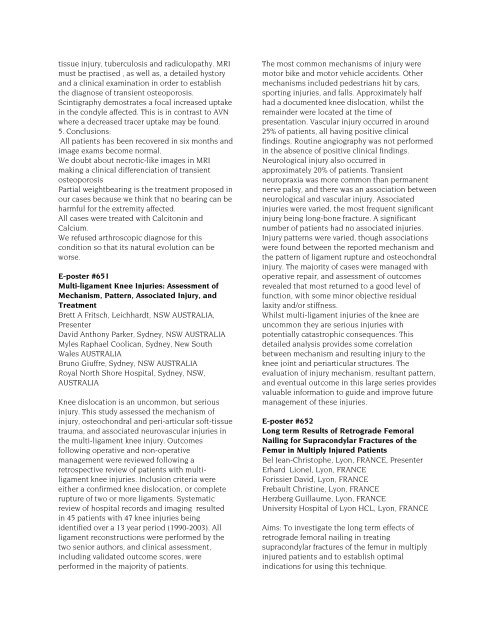POSTER ABSTRACTS - ISAKOS
POSTER ABSTRACTS - ISAKOS
POSTER ABSTRACTS - ISAKOS
Create successful ePaper yourself
Turn your PDF publications into a flip-book with our unique Google optimized e-Paper software.
tissue injury, tuberculosis and radiculopathy. MRI<br />
must be practised , as well as, a detailed hystory<br />
and a clinical examination in order to establish<br />
the diagnose of transient osteoporosis.<br />
Scintigraphy demostrates a focal increased uptake<br />
in the condyle affected. This is in contrast to AVN<br />
where a decreased tracer uptake may be found.<br />
5. Conclusions:<br />
All patients has been recovered in six months and<br />
image exams become normal.<br />
We doubt about necrotic-like images in MRI<br />
making a clinical differenciation of transient<br />
osteoporosis<br />
Partial weightbearing is the treatment proposed in<br />
our cases because we think that no bearing can be<br />
harmful for the extremity affected.<br />
All cases were treated with Calcitonin and<br />
Calcium.<br />
We refused arthroscopic diagnose for this<br />
condition so that its natural evolution can be<br />
worse.<br />
E-poster #651<br />
Multi-ligament Knee Injuries: Assessment of<br />
Mechanism, Pattern, Associated Injury, and<br />
Treatment<br />
Brett A Fritsch, Leichhardt, NSW AUSTRALIA,<br />
Presenter<br />
David Anthony Parker, Sydney, NSW AUSTRALIA<br />
Myles Raphael Coolican, Sydney, New South<br />
Wales AUSTRALIA<br />
Bruno Giuffre, Sydney, NSW AUSTRALIA<br />
Royal North Shore Hospital, Sydney, NSW,<br />
AUSTRALIA<br />
Knee dislocation is an uncommon, but serious<br />
injury. This study assessed the mechanism of<br />
injury, osteochondral and peri-articular soft-tissue<br />
trauma, and associated neurovascular injuries in<br />
the multi-ligament knee injury. Outcomes<br />
following operative and non-operative<br />
management were reviewed following a<br />
retrospective review of patients with multiligament<br />
knee injuries. Inclusion criteria were<br />
either a confirmed knee dislocation, or complete<br />
rupture of two or more ligaments. Systematic<br />
review of hospital records and imaging resulted<br />
in 45 patients with 47 knee injuries being<br />
identified over a 13 year period (1990-2003). All<br />
ligament reconstructions were performed by the<br />
two senior authors, and clinical assessment,<br />
including validated outcome scores, were<br />
performed in the majority of patients.<br />
The most common mechanisms of injury were<br />
motor bike and motor vehicle accidents. Other<br />
mechanisms included pedestrians hit by cars,<br />
sporting injuries, and falls. Approximately half<br />
had a documented knee dislocation, whilst the<br />
remainder were located at the time of<br />
presentation. Vascular injury occurred in around<br />
25% of patients, all having positive clinical<br />
findings. Routine angiography was not performed<br />
in the absence of positive clinical findings.<br />
Neurological injury also occurred in<br />
approximately 20% of patients. Transient<br />
neuropraxia was more common than permanent<br />
nerve palsy, and there was an association between<br />
neurological and vascular injury. Associated<br />
injuries were varied, the most frequent significant<br />
injury being long-bone fracture. A significant<br />
number of patients had no associated injuries.<br />
Injury patterns were varied, though associations<br />
were found between the reported mechanism and<br />
the pattern of ligament rupture and osteochondral<br />
injury. The majority of cases were managed with<br />
operative repair, and assessment of outcomes<br />
revealed that most returned to a good level of<br />
function, with some minor objective residual<br />
laxity and/or stiffness.<br />
Whilst multi-ligament injuries of the knee are<br />
uncommon they are serious injuries with<br />
potentially catastrophic consequences. This<br />
detailed analysis provides some correlation<br />
between mechanism and resulting injury to the<br />
knee joint and periarticular structures. The<br />
evaluation of injury mechanism, resultant pattern,<br />
and eventual outcome in this large series provides<br />
valuable information to guide and improve future<br />
management of these injuries.<br />
E-poster #652<br />
Long term Results of Retrograde Femoral<br />
Nailing for Supracondylar Fractures of the<br />
Femur in Multiply Injured Patients<br />
Bel Jean-Christophe, Lyon, FRANCE, Presenter<br />
Erhard Lionel, Lyon, FRANCE<br />
Forissier David, Lyon, FRANCE<br />
Frebault Christine, Lyon, FRANCE<br />
Herzberg Guillaume, Lyon, FRANCE<br />
University Hospital of Lyon HCL, Lyon, FRANCE<br />
Aims: To investigate the long term effects of<br />
retrograde femoral nailing in treating<br />
supracondylar fractures of the femur in multiply<br />
injured patients and to establish optimal<br />
indications for using this technique.
















